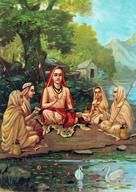Adi Shankara

photo credits: Wikimedia Commons
Adi Shankara, also called Adi Shankaracharya (Sanskrit: आदि शङ्कर, आदि शङ्कराचार्य, romanized: Ādi Śaṅkara, Ādi Śaṅkarācārya, lit. 'First Shankaracharya', pronounced [aːdɪ ɕɐŋkɐraːt͡ɕaːrjɐ]), was an 8th-century Indian Vedic scholar and teacher (acharya). His works present a harmonizing reading of the sastras, with liberating knowledge of the self at its core, synthesizing the Advaita Vedanta teachings of his time.Due to his later fame, over 300 texts are attributed to him, including commentaries (Bhāṣya), introductory topical expositions (Prakaraṇa grantha) and poetry (Stotra). However, most of these are likely to be written by admirers or pretenders or scholars with an eponymous name. Works known to be written by Shankara himself are the Brahmasutrabhasya, his commentaries on ten principal Upanishads, his commentary on the Bhagavad Gita, and the Upadeśasāhasrī. The authenticity of Shankara being the author of Vivekacūḍāmaṇi has been questioned and mostly rejected by scholarship.The central concern of Shankara's writings is the liberating knowledge of the true identity of jivatman (individual self) as Ātman-Brahman, taking the Upanishads as an independent means of knowledge, beyond the ritually-oriented Mīmāṃsā-exegesis of the Vedas. Shankara's Advaita shows influences from Mahayana Buddhism, despite Shankara's critiques; and Hindu Vaishnava opponents have even accused Shankara of being a "crypto-Buddhist," a qualification which is rejected by the Advaita Vedanta tradition, highlighting their respective views on Atman, Anatta and Brahman.Shankara has an unparallelled status in the tradition of Advaita Vedanta, but his influence on Hindu intellectual thought has been questioned. Until the 10th century Shankara was overshadowed by his older contemporary Maṇḍana Miśra, and there is no mention of him in concurring Hindu, Buddhist or Jain sources until the 11th century. The popular image Shankara started to take shape in the 14th century, centuries after his death, when Sringeri matha started to receive patronage from the kings of the Vijayanagara Empire and shifted their allegiance from advaitic Agamic Saivism to Brahmanical Advaita orthodoxy. Hagiographies dating from the 14th-17th centuries deified him as a ruler-renunciate, travelling on a digvijaya (conquest of the four quarters) across the Indian subcontinent to propagate his philosophy, defeating his opponents in theological debates. These hagiographies portray him as founding four mathas ("monasteries"), and Adi Shankara also came to be regarded as the organiser of the Dashanami monastic order, and the unifier of the Shanmata tradition of worship. The title of Shankaracharya, used by heads of certain monasteries in India, is derived from his name. Source: Wikipedia (en)
Authors influenced by Adi Shankara 2
Human - wd:Q180967


